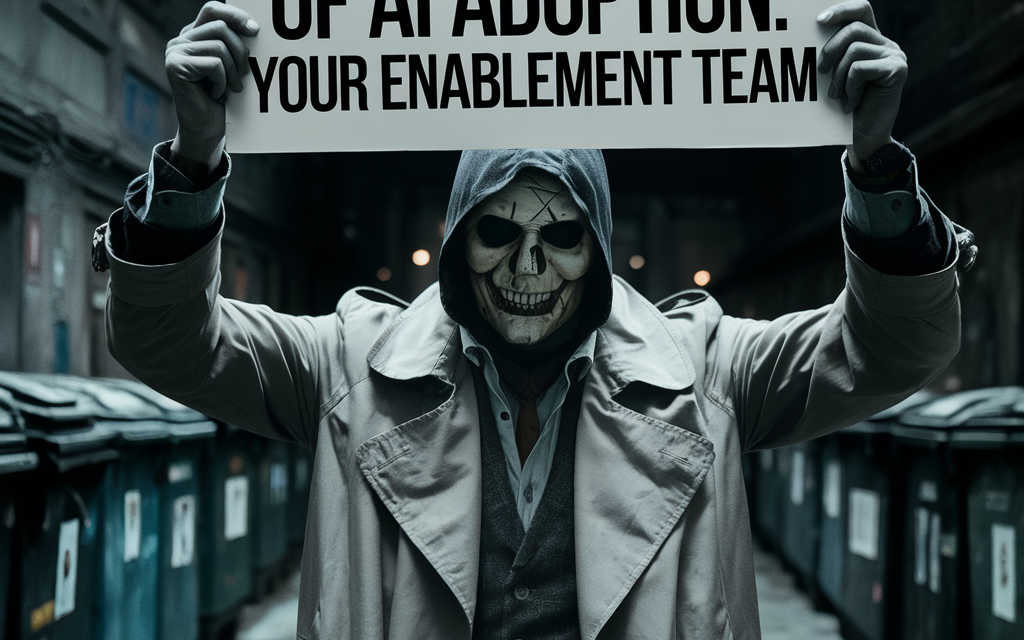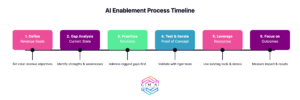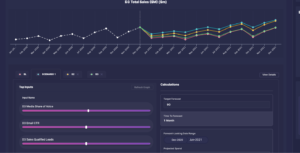
The Silent Killer of AI Adoption: Your Enablement Team

For over 13 years, I’ve been immersed in the enablement community, often finding myself as both a champion and critic of its evolution. I’ve witnessed enablement teams rise to strategic heights, driving tangible business outcomes, and others falter, stuck in the rut of reactivity, never becoming the force multipliers they were meant to be. This dichotomy becomes painfully apparent when it comes to adopting AI.
Let’s be clear: the problem isn’t just enablement teams. It’s also the leaders who fail to understand or empower this function as a strategic partner. When AI adoption is stymied, it’s rarely the fault of the technology. Instead, the issue lies with the people meant to drive change—often those who should act as the linchpins of transformation. It’s not just frustrating; it’s tragic.
Enablement: A Reactive Problem in an AI-Powered World
Enablement, when reactive, epitomizes the very dysfunction that hinders AI adoption. I’ve seen it firsthand: teams overwhelmed with last-minute training requests, scrambling to respond to pipeline drops or missed targets. In this mode, enablement is reduced to triage, with no room for the kind of strategic thinking required to implement transformative technology like AI.
The frustrating part is that enablement should never be this way. Done right, it’s a strategic powerhouse, a data-driven “Head Gamemaker” to the CRO’s “emperor” using the Hunger games analogy, but instead of trying to kill people, they are designing and orchestrating an environment where revenue teams thrive. This means anticipating challenges, aligning programs with revenue and finance goals, and ensuring every enablement initiative contributes to business outcomes. AI adoption demands this level of foresight, yet many enablement teams are ill-prepared to rise to the occasion.

Reactive enablement teams perpetuate a vicious cycle. They lack the time or capacity to educate themselves on AI tools, let alone teach others. Instead of becoming advocates for innovation, they become bottlenecks, dragging out implementation timelines and eroding trust across the organization.
The Real Problem: Leaders and Enablement Teams Alike
This isn’t just an enablement issue—it’s a leadership issue. Far too often, leaders treat enablement as a reactive, tactical function rather than the strategic lever it can and should be. Whether it’s failing to provide enablement with a seat at the table or undervaluing its potential to drive systemic change, leaders unwittingly thwart their own efforts at innovation.
Let’s paint a picture: A VP of Sales introduces an AI tool because it looks cool, thinking it will revolutionize pipeline management. But they involve enablement late in the game, providing no time for the team to deeply understand the technology, have no ideal outcomes or measurable impact, or align it with existing workflows. Training becomes a check-the-box exercise, adoption falters, and the tool is eventually abandoned. Who gets blamed? Enablement. But the truth is, both leadership and enablement failed to approach the initiative strategically.
For AI to succeed, leaders must empower enablement to operate like McKinsey-level internal consultants—strategic, data-centric, and aligned to the broader business environment. Enablement must not only have the skills to drive AI adoption but also the mandate to influence how it’s implemented across teams by literally becoming like a McKinsey-level internal consultant.
What Good Looks Like (WGLL) in AI-Powered Enablement
Strategic enablement doesn’t happen by accident, it requires a clear vision, a data-driven approach, and a relentless focus on business outcomes. For AI to transform enablement into a true revenue driver, the process must start with clarity on end goals, followed by a structured approach to identifying and addressing the gaps that matter most.

1. Start with the End in Mind: Define Revenue Goals
Effective enablement begins with alignment to the organization’s most critical revenue objectives. These goals could include increasing win rates, shortening sales cycles, improving forecast accuracy, or expanding customer retention. Without clarity on these outcomes, AI adoption risks becoming just another shiny object.
For example, if the goal is to increase average deal size by 15%, enablement must work backward to identify what’s currently preventing reps from upselling or cross-selling effectively. Similarly, if the goal is to reduce time-to-close, enablement must uncover what’s causing delays at specific sales stages.
2. Conduct a Gap Analysis
Once revenue goals are defined, a gap analysis becomes the foundation for building an AI-powered enablement strategy. This involves identifying:
- Weaknesses: What are the current barriers or challenges preventing the team from hitting revenue targets?
- Strengths to Amplify: What existing capabilities or processes could be further optimized using AI?
For example:
- If the challenge is poor pipeline visibility, tools like AI-driven forecasting or conversation intelligence can provide real-time insights.
- If the team struggles with buyer engagement, AI tools for personalization or dynamic content delivery can help address this gap.
- If reps are already strong at discovery but lack speed in follow-ups, automation tools can accelerate deal progression by handling routine tasks.
The gap analysis ensures that AI investments are targeted and tied directly to revenue priorities. It also helps teams avoid the pitfall of implementing technology for technology’s sake.
3. Prioritize Solutions to Address the Biggest Gaps
Not all gaps are created equal. Enablement must prioritize addressing the challenges that have the greatest impact on revenue goals or that can be solved most effectively with AI. The focus should be on high-leverage problems where AI can provide quick wins or substantial improvements.
For example, if your team’s ability to handle objections during demos is a bottleneck, prioritize implementing an AI-powered role-playing tool that can help reps practice and refine their skills. If a major strength is your reps’ responsiveness, focus on tools that can automate scheduling and follow-ups to capitalize on this advantage.
4. Test and Iterate with a Proof of Concept
Before rolling out AI across the entire team, start with a proof of concept (PoC) using a test tiger team—a small, agile group of respected sales reps who can test the technology in real-world scenarios and later be champions of any tech brought on to the entire team. This allows enablement to validate the tool’s effectiveness and identify potential challenges before scaling as well as having having the sales reps that the team respects lead the way of showing people how they actually use it in practice, not just theory.
During the PoC, measure the tool’s impact on the prioritized gaps identified in the analysis. For example:
- Did the AI tool reduce deal stagnation in specific pipeline stages?
- Did it help increase response rates for targeted buyer segments?
- Did automation free up reps’ time to focus on strategic selling?
By iterating based on real-world feedback, enablement can refine its approach and build confidence in the solution.
5. Leverage Free Resources to Explore Tools
Enablement leaders don’t have to start from scratch when evaluating AI tools. Resources like the GTM AI Demo Tools Library provide a wealth of demos and examples, or using the list of 1250 AI sales tools with ColdIQ helping teams identify solutions that align with their needs. Use these resources to narrow down options, compare features, and see real-world use cases.
6. Focus on High-Impact Outcomes
AI-powered enablement isn’t about flashy tools or endless features—it’s about driving outcomes that matter. The ultimate measure of success is whether your enablement efforts lead to meaningful improvements in revenue performance. Whether that’s a higher close rate, faster deal velocity, or increased team efficiency, every AI initiative should be tied to tangible results.
By starting with clear goals, conducting a rigorous gap analysis, and prioritizing the right solutions, enablement teams can transform their approach to AI, moving from reactive execution to strategic, outcome-focused innovation. This is what good looks like—and it’s how enablement becomes a true force multiplier for revenue teams.
Why Strategic Enablement Must Be AI-Powered
AI is not just another tool—it’s a paradigm shift. It amplifies the impact of enablement programs, turning reactive functions into strategic engines of growth. When enablement teams harness AI, they can:
- Predict skill gaps before they become problems.
- Automate repetitive tasks, freeing time for high-impact initiatives.
- Provide reps with real-time insights and recommendations that drive better outcomes.
- Use data to prove the ROI of their programs to leadership, securing ongoing investment.
The irony is that while AI is a natural fit for strategic enablement, many teams remain unaware of its potential or lack the skills to leverage it. The result is a tragic missed opportunity—not just for enablement, but for the organization as a whole.
Enablement as the Gamemaker: Crafting Environments for Success
In “The Hunger Games,” the Gamemaker creates the conditions for victory or defeat and the players of the games never know who it is behind the scenes. They design the battlefield, control the resources, and orchestrate the challenges that shape the tributes’ fate. In the world of GTM, sales, customer success, partners or business development, enablement functions much the same way. The environment enablement creates—through tools, processes, and training—determines whether sales teams thrive or flounder. In my opinion, the best enablement functions perform in such a way where the teams do not know that enablement team is the reason why their lives are better, they just love their environment because they win.
When enablement is strategic and AI-powered, it becomes an unstoppable force, crafting an ecosystem tailored for success. It doesn’t just respond to challenges; it anticipates them, aligning every resource with the ultimate objective: revenue growth. This is enablement at its best—data-driven, aligned to financial goals, and outcome-focused.
Kunal Pandya of Sales Velocity Labs champions a clear mission for enablement: act as a strategic driver. This means focusing on metrics that matter—deal size, win rates, time-to-close—while directly impacting revenue outcomes. AI takes these principles further, enabling enablement teams to build adaptive systems that provide real-time insights, streamline workflows, and empower sales reps with precision. It’s not just about making incremental improvements; it’s about architecting success at scale.

from salesvelocitylabs.com
AI in Action: Tools That Transform Enablement
In the dynamic landscape of enablement, innovative AI-driven tools are revolutionizing traditional practices, enhancing efficiency, and driving measurable outcomes. Here’s how some cutting-edge platforms are transforming the field:
(ps. no I am not paid in any way to promote these tools or any tool I suggest in my blogs here, I just genuinely think they kickass)
Luster.ai: AI-Powered Sales Training
Traditional role-playing exercises can be subjective and resource-intensive. Luster.ai addresses this by offering AI-driven practice sessions that simulate realistic sales scenarios. These sessions identify and bridge skill gaps before they impact customer interactions, providing a scalable alternative to conventional methods.
AskElephant.ai: Streamlined Workflow Automation
Effective enablement requires timely access to relevant information. AskElephant.ai automates workflows for go-to-market teams, streamlining tasks such as pre-meeting preparation, CRM note-taking, and team handoffs. This allows teams to focus on building customer relationships and driving revenue, ensuring that critical information is readily available when needed.
Rox.com: AI-Powered Sales Productivity
Time spent on account research can detract from selling activities. Rox.com reshapes how sales teams manage and grow revenue by combining fragmented data into a unified system of record. It delivers insights through always-on AI agent swarms, enabling sales professionals to access comprehensive account information efficiently.
CloseStrong.ai: Precision-Guided Selling
Pipeline reviews often focus retrospectively, missing opportunities for proactive improvement. CloseStrong.ai introduces Precision Guided Selling™, a sustained approach that reinforces and guides sellers across every stage of the sales cycle. This method provides continuous support, helping sales representatives qualify leads, identify competitive advantages, manage risks, execute discovery, and craft value-driven proposals.
Grw.ai: Scalable Performance Coaching
Scaling personalized coaching across large sales teams is challenging. Grw.ai delivers expert, human-like coaching tailored to individual needs. It supports sales reps and leaders across various situations, enhancing selling abilities and ensuring consistent improvement without overburdening managers.
By integrating these AI-powered tools, enablement teams can transition from reactive to proactive strategies, fostering sales professionals are equipped to excel. This alignment with revenue goals and measurable outcomes transforms enablement into a strategic driver of business success.
AI as the Missing Link: Proving Enablement’s Value
One of the enduring challenges in enablement is demonstrating its direct impact on revenue. Traditional metrics often fall short in establishing clear cause-and-effect relationships between enablement activities and business outcomes. This is where AI-driven platforms like Proof Analytics become indispensable.
Causal Analytics
Proof Analytics offers a SaaS platform that enables organizations to run real-time cause-and-effect scenarios, providing accurate forecasting and optimization models. By integrating with existing data sources, it allows enablement teams to quantify how specific initiatives—such as targeted training programs or content delivery systems—directly influence key performance indicators like deal velocity and win rates. This causal analysis clarifies the effectiveness of enablement strategies, offering insights that are both actionable and understandable to finance teams.

Predictive Insights
Beyond assessing past initiatives, Proof Analytics employs advanced predictive models to forecast the future impact of enablement activities. By analyzing patterns in historical data, the platform can predict which training programs or resources will yield the highest return on investment. This foresight enables enablement leaders to prioritize efforts that align closely with revenue objectives, ensuring that resources are allocated to initiatives with the greatest potential impact.
By leveraging the capabilities of platforms like Proof Analytics, enablement teams can transition from intuition-based strategies to data-driven decision-making. This shift not only substantiates the value of enablement but also aligns its activities more closely with overarching business goals, ultimately driving sustained revenue growth.
The Leadership Imperative: Demand More of Enablement and Yourself
I’ve spent over 13 years working alongside and learning from enablement teams and revenue leaders. I’ve seen their potential, and I believe in both deeply. Revenue leaders bring the vision, the strategy, and the ability to execute with precision. Enablement teams have the unique power to design and orchestrate the systems that make those visions a reality. Together, they should be an unstoppable force that drives growth, inspires teams, and delivers tangible results. Yet, too often, the full power of this partnership remains unrealized.
This is not a question of capability but of commitment. Leaders must push for a world where enablement and revenue leadership don’t just coexist, they amplify each other. The only way to get there is for both parties to demand more of themselves, of each other, and of the tools and processes they rely on.
Demand Strategic Alignment: Invest in Tools or Be the Problem
Enablement should never be relegated to a tactical support role, yet this happens all too often when leaders fail to prioritize the right investments. Strategic enablement requires alignment with revenue and financial goals, not just in theory but in practice. This means rejecting a reactive, piecemeal approach that treats enablement as a patch for immediate challenges. Instead, leaders must challenge enablement to operate as a proactive, strategic driver of outcomes.
When leaders fail to invest in these tools, they create the very problems they expect enablement to solve. Without technology to automate workflows, provide real-time insights, and deliver personalized coaching, enablement is forced into a reactive cycle of playing catch-up. This perpetuates inefficiency, misalignment, and frustration—not just for enablement teams but for the revenue leaders depending on them.
Enablement’s power is directly tied to the resources it’s given. In the age of AI, this means prioritizing tools that empower enablement to act as the Gamemaker of the sales world. The Gamemaker doesn’t just react to the environment; they design it, creating conditions where success is inevitable. For enablement to function at this level, leaders must make bold investments in technology that supports this vision.
The tools we’ve discussed—platforms for predictive coaching, real-time feedback, and causal analytics—aren’t just nice to have; they’re essential. Without them, enablement can’t design the dynamic systems needed to align sales teams with revenue goals. Worse, the lack of these tools limits enablement’s ability to measure its own impact, leaving the function vulnerable to being dismissed as a cost center rather than a strategic asset.
When leaders withhold investments in these capabilities, they undermine their own revenue goals. It’s not just enablement that suffers—sales performance, team alignment, and overall business outcomes are directly impacted.
Enablement Is an Investment Center, Not a Cost Center
One of the biggest misconceptions about enablement is that it’s a cost center—a necessary expense that supports other functions but doesn’t directly contribute to revenue. This mindset is outdated and fundamentally flawed. Enablement, when equipped with the right tools and strategies, is an investment center that drives measurable growth, improves team performance, and maximizes ROI across the entire GTM organization.
Every dollar spent on enablement or enablement tools, training, and technology has the potential to increase deal velocity, raise win rates, and shorten sales cycles. AI-powered enablement platforms make this possible by enabling AND proving the impact of enablement efforts in real time. These tools don’t just support enablement—they turn it into a revenue-driving powerhouse.

By treating enablement as an investment center, leaders empower it to act as a strategic driver, creating the systems and infrastructure that enable sales teams to succeed. This includes not only equipping enablement with AI tools but also providing the resources to measure and communicate their impact effectively. When enablement can clearly demonstrate how it contributes to revenue growth, it ceases to be seen as a support function and is recognized for what it truly is: an essential partner in driving business success.
Lead by Example
Great leaders don’t just set expectations—they embody them. If you want your teams to embrace AI, innovation, and strategic thinking, you must model those behaviors yourself. Use AI tools to optimize your own workflows. Share your experiences with your team, highlighting both the challenges and the rewards. Show them what’s possible when technology and strategy come together.
Leadership isn’t about standing on the sidelines and pointing the way forward. It’s about walking the path alongside your team, demonstrating the commitment and curiosity you expect from them. When leaders embrace change and innovation, they create a culture where others feel empowered to do the same.
The Full Power of Revenue and Enablement Realized

Can you tell my age yet?
I believe in a world where the potential of revenue leaders and enablement teams is fully realized. A world where revenue leaders leverage their vision to drive strategic goals and enablement teams bring those goals to life with precision and impact. Together, they are greater than the sum of their parts, capable of achieving outcomes that neither could accomplish alone.
This isn’t just an aspiration—it’s a call to action. Leaders, it’s time to expect more from enablement. Enablement, it’s time to demand more from your leaders. Both must rise to the occasion, embracing the tools, strategies, and mindsets needed to succeed in an AI-powered world.
Enablement is the catalyst for success, proactively shaping outcomes and driving strategy. It’s not a support function, it’s the engine of growth and transformation. With the right leadership, it becomes the ultimate game maker, crafting environments where sales teams thrive, revenue grows, and businesses achieve their full potential.
The future of enablement is here. The question isn’t whether it will transform your business—it’s whether you will lead the way.
































